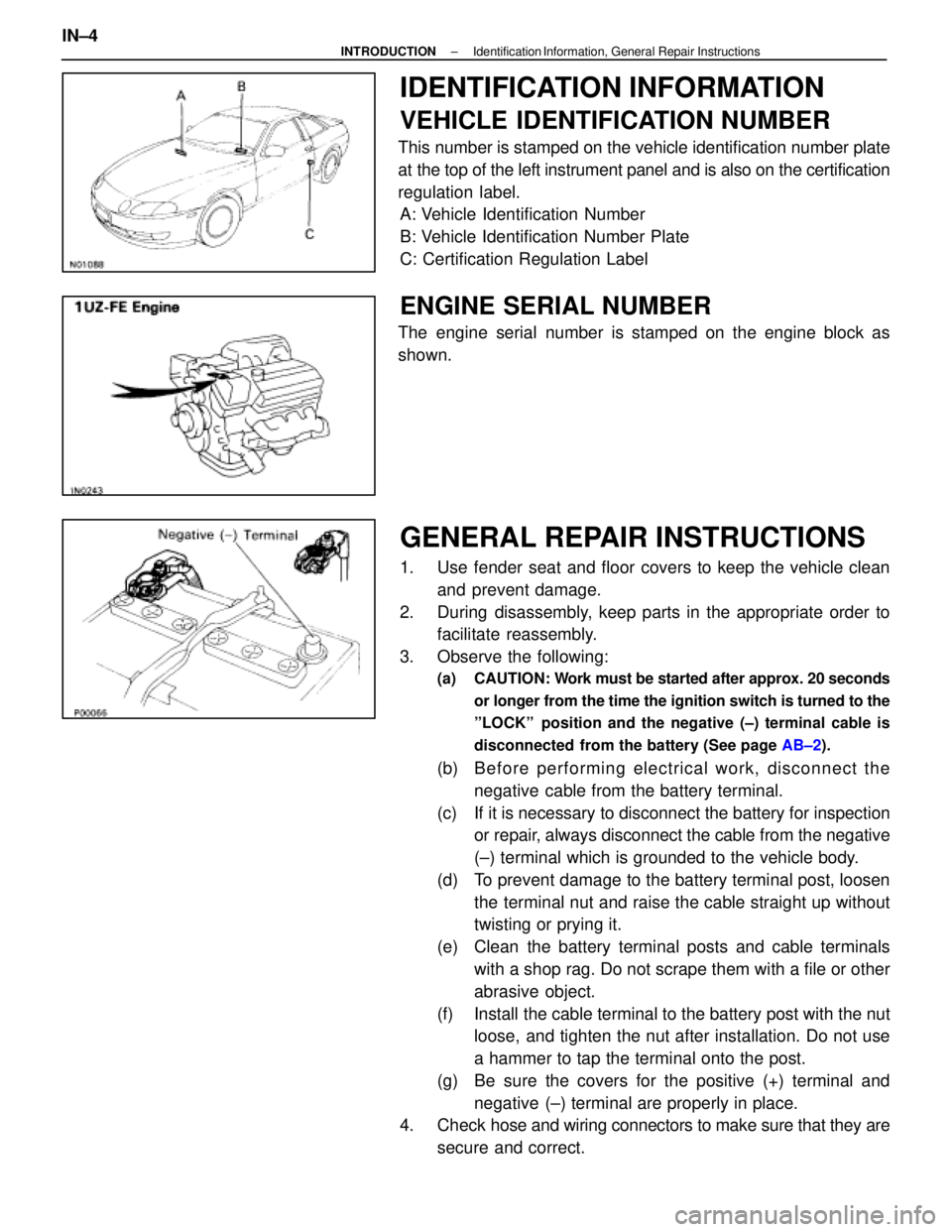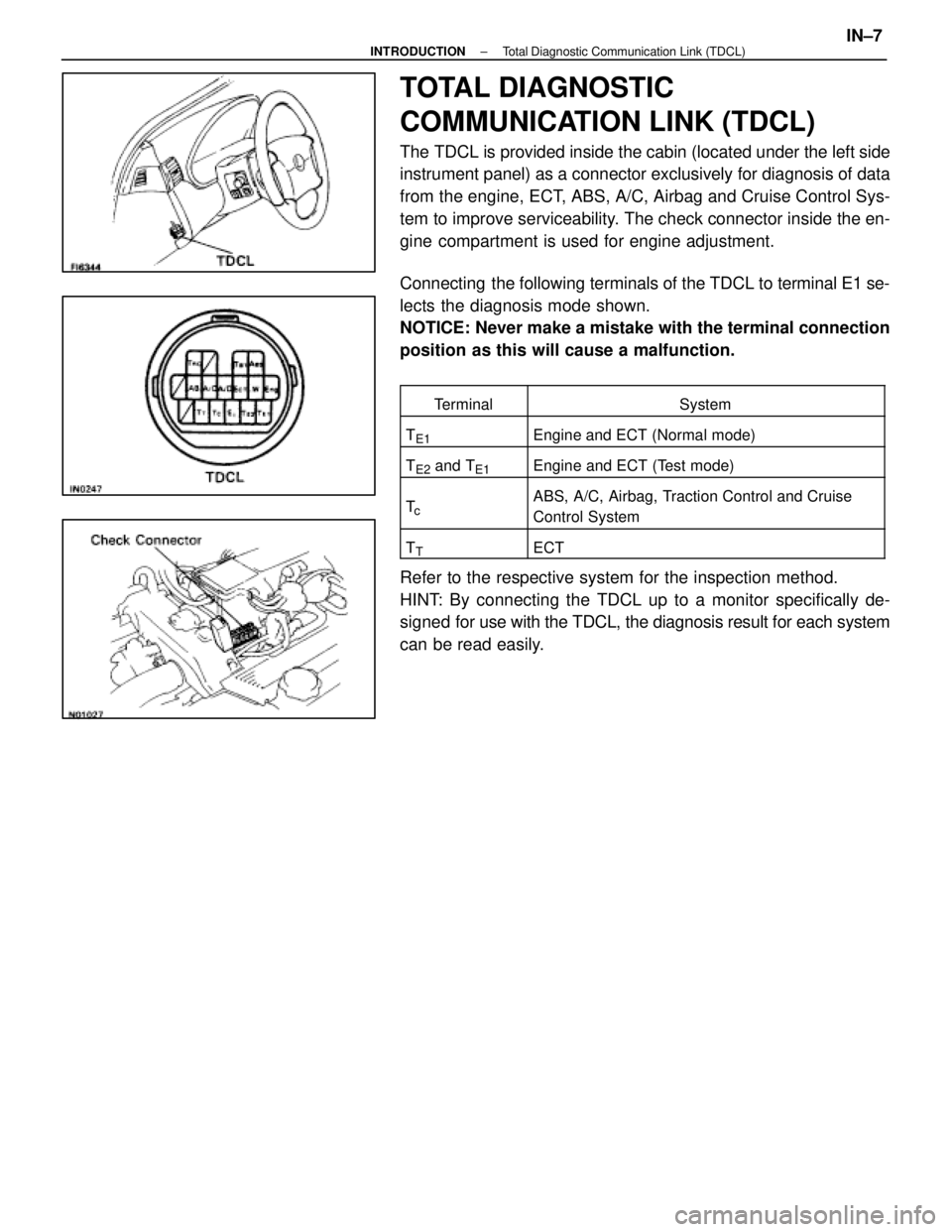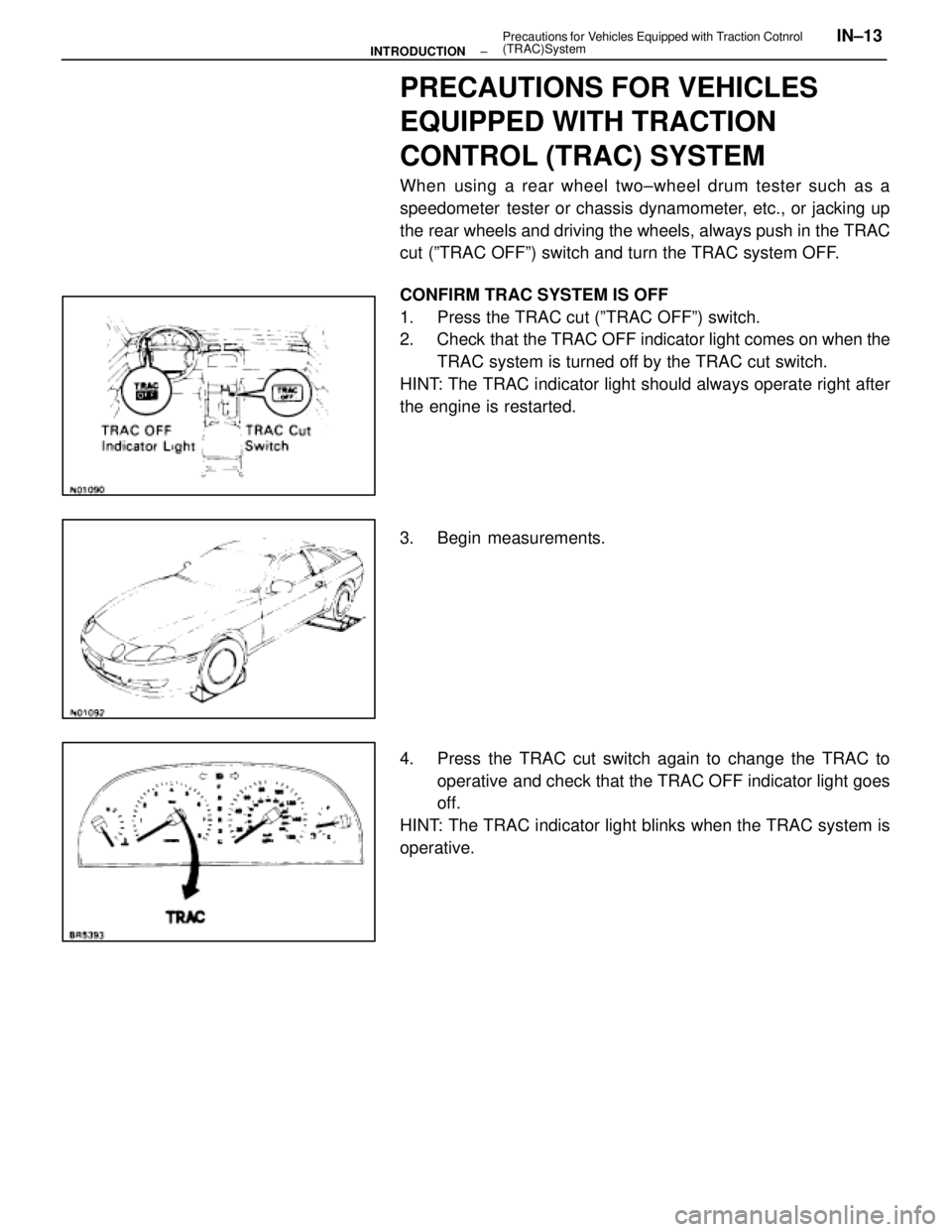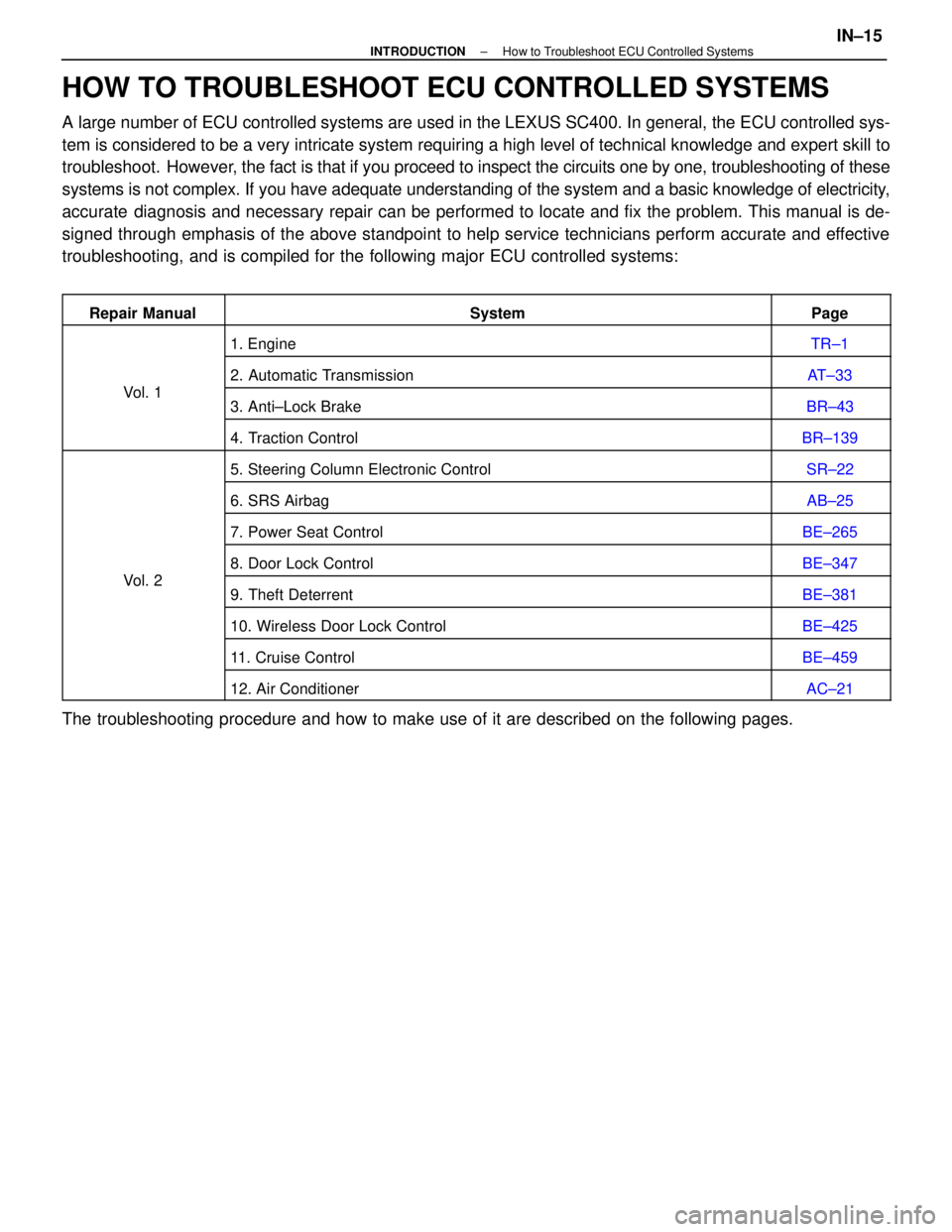1991 LEXUS SC400 engine
[x] Cancel search: enginePage 7 of 4087

IDENTIFICATION INFORMATION
VEHICLE IDENTIFICATION NUMBER
This number is stamped on the vehicle identification number plate
at the top of the left instrument panel and is also on the certification
regulation label.A: Vehicle Identification Number
B: Vehicle Identification Number Plate
C: Certification Regulation Label
ENGINE SERIAL NUMBER
The engine serial number is stamped on the engine block as
shown.
GENERAL REPAIR INSTRUCTIONS
1. Use fender seat and floor covers to keep the vehicle clean
and prevent damage.
2. During disassembly, keep parts in the appropriate order to facilitate reassembly.
3. Observe the following:
(a) CAUTION: W ork must be started after approx. 20 seconds
or longer from the time the ignition switch is turned to the
ºLOCKº position and the negative (±) terminal cable is
disconnected from the battery (See page AB±2).
(b) B e fo re pe rfo rmin g ele ctrica l wo rk, disc onnect the
negative cable from the battery terminal.
(c) If it is necessary to disconnect the battery for inspection or repair, always disconnect the cable from the negative
(±) terminal which is grounded to the vehicle body.
(d) To prevent damage to the battery terminal post, loosen the terminal nut and raise the cable straight up without
twisting or prying it.
(e) Clean the battery terminal posts and cable terminals with a shop rag. Do not scrape them with a file or other
abrasive object.
(f) Install the cable terminal to the battery post with the nut loose, and tighten the nut after installation. Do not use
a hammer to tap the terminal onto the post.
(g) Be sure the covers for the positive (+) terminal and negative (±) terminal are properly in place.
4. Check hose and wiring connectors to make sure that they are
secure and correct.
IN±4
±
INTRODUCTION Identification Information, General Repair Instructions
WhereEverybodyKnowsYourName
Page 9 of 4087

12. Observe the following precautions to avoid damage to theparts:
(a) Do not open the cover or case of the ECU unless
absolutely necessary (If the IC terminals are touched, the
IC may be destroyed by static electricity.).
(b) To pull apart electrical connectors, pull on the connectoritself, not the wires (See page BE±2).
(c) Be careful not to drop electrical components, such as sensors or relays. It they are dropped on a hard floor,
they should be replaced and not reused.
(d) When checking continuity at the wire connector, insert the tester probe carefully to prevent terminals from
bending.
(e) To disconnect vacuum hoses, pull on the end, not the middle of the hose.
(f) When steam cleaning an engine, protect the distributor,
coil and air filter from water.
(g) Ne ve r use an imp a ct wre n ch to re mo ve or in sta ll temperature switches or temperature sensors.
(h) When using a vacuum gauge, never force the hose onto
a connector that is too large. Use a step±down adapter
instead. Once the hose has been stretched, it may leak.
13. Tag hoses before disconnecting them: (a) When disconnecting vacuum hoses, use tags to identify
how they should be reconnected.
(b) After completing a job, double check that the vacuum hoses are properly connected. A label under the hood
shows the proper layout.
14. Installation of wheels The wheel assemblies are of the uni±directional type and
must be rotated only between the front and rear as illustrated.
Wheels are marked with turning direction indicators.
When installing the wheels, check the marks carefully and
install the wheel correctly.
15. Bleeding of traction control system When repairing the brake master cylinder or TRAC system,
bleed the air out of the TRAC system (See page BR±7).
CAUTION: Since the fluid is under high pressure, it could
spray out with great force, so be careful.
IN±6
±
INTRODUCTION General Repair Instructions
WhereEverybodyKnowsYourName
Page 10 of 4087

TOTAL DIAGNOSTIC
COMMUNICATION LINK (TDCL)
The TDCL is provided inside the cabin (located under the left side
instrument panel) as a connector exclusively for diagnosis of data
from the engine, ECT, ABS, A/C, Airbag and Cruise Control Sys-
tem to improve serviceability. The check connector inside the en-
gine compartment is used for engine adjustment.
Connecting the following terminals of the TDCL to terminal E1 se-
lects the diagnosis mode shown.
NOTICE: Never make a mistake with the terminal connection
position as this will cause a malfunction.
TerminalSystem
TE1Engine and ECT (Normal mode)
TE2 and TE1Engine and ECT (Test mode)
TcABS, A/C, Airbag, Traction Control and Cruise
Control System
TTECT
Refer to the respective system for the inspection method.
HINT: By connecting the TDCL up to a monitor specifically de-
signed for use with the TDCL, the diagnosis result for each system
can be read easily.
±
INTRODUCTION Total Diagnostic Communication Link (TDCL)IN±7
WhereEverybodyKnowsYourName
Page 15 of 4087

PRECAUTIONS FOR VEHICLES
EQUIPPED WITH A CATALYTIC
CONVERTER
CAUTION: If large amounts of unburned gasoline flow into the
converter, it may overheat and create a fire hazard. To prevent
this, observe the following precautions and explain them to
your customer.
1. Use only unleaded gasoline.
2. Avoid prolonged idling. Avoid running the engine at idle speed for more than 20 min-
utes.
3. Avoid spark jump test. (a) P e r f o r m s p a r k j u m p t e s t o n l y w h e n a b s o l u t e l ynecessary. Perform this test as rapidly as possible.
(b) While testing, never race the engine.
4. Avoid prolonged engine compression measurement.
Engine compression tests must be done as rapidly as pos-
sible.
5. Do not run engine when fuel tank is nearly empty. This may c ause the engine to misfire and create an extra load
on the converter.
6. Avoid coasting with ignition turned off and prolonged braking.
7. Do not dispose of used catalyst along with parts contaminated with gasoline or oil.
IN±12
±
INTRODUCTION Precautions for Vehicles Equipped with a Catalytic
Converter
WhereEverybodyKnowsYourName
Page 16 of 4087

PRECAUTIONS FOR VEHICLES
EQUIPPED WITH TRACTION
CONTROL (TRAC) SYSTEM
When using a rear wheel two±wheel drum tester such as a
speedometer tester or chassis dynamometer, etc., or jacking up
the rear wheels and driving the wheels, always push in the TRAC
cut (ºTRAC OFFº) switch and turn the TRAC system OFF.
CONFIRM TRAC SYSTEM IS OFF
1. Press the TRAC cut (ºTRAC OFFº) switch.
2. Check that the TRAC OFF indicator light comes on when the
TRAC system is turned off by the TRAC cut switch.
HINT: The TRAC indicator light should always operate right after
the engine is restarted.
3. Begin measurements.
4. Press the TRAC cut switch again to change the TRAC to operative and check that the TRAC OFF indicator light goes
off.
HINT: The TRAC indicator light blinks when the TRAC system is
operative.
±
INTRODUCTION Precautions for V
ehicles Equipped with Traction Cotnrol
(TRAC)SystemIN±13
WhereEverybodyKnowsYourName
Page 18 of 4087

HOW TO TROUBLESHOOT ECU CONTROLLED SYSTEMS
A large number of ECU controlled systems are used in the LEXUS SC400. In \
general, the ECU controlled sys-
tem is considered to be a very intricate system requiring a high level o\
f technical knowledge and expert skill to
troubleshoot. However, the fact is that if you proceed to inspect the circuits one by one, trou\
bleshooting of these
systems is not complex. If you have adequate understanding of the system\
and a basic knowledge of electricity,
accurate diagnosis and necessary repair can be performed to locate and fix the p\
roblem. This manual is de-
signed through emphasis of the above standpoint to help service technici\
ans perform accurate and effective
troubleshooting, and is compiled for the following major ECU controlled \
systems:
Repair ManualSystemPage
1. EngineTR±1
Vl1
2. Automatic TransmissionAT±33
Vol. 13. Anti±Lock BrakeBR±43
4. Traction ControlBR±139
5. Steering Column Electronic ControlSR±22
6. SRS AirbagAB±25
7. Power Seat ControlBE±265
Vl2
8. Door Lock ControlBE±347
Vol. 29. Theft DeterrentBE±381
10. Wireless Door Lock ControlBE±425
11. Cruise ControlBE±459
12. Air ConditionerAC±21
The troubleshooting procedure and how to make use of it are described on\
the following pages.
±
INTRODUCTION How to Troubleshoot ECU Controlled SystemsIN±15
WhereEverybodyKnowsYourName
Page 20 of 4087
![LEXUS SC400 1991 Service Repair Manual
[1] CUSTOMER PROBLEM ANALYSIS
In troubleshooting, the problem symptoms must be confirmed accurately and \
all preconceptions must be
cleared away in order to give an accurate judgment. To ascertain j LEXUS SC400 1991 Service Repair Manual
[1] CUSTOMER PROBLEM ANALYSIS
In troubleshooting, the problem symptoms must be confirmed accurately and \
all preconceptions must be
cleared away in order to give an accurate judgment. To ascertain j](/manual-img/36/57051/w960_57051-19.png)
[1] CUSTOMER PROBLEM ANALYSIS
In troubleshooting, the problem symptoms must be confirmed accurately and \
all preconceptions must be
cleared away in order to give an accurate judgment. To ascertain just what the problem symptoms are, it is ex-
tremely important to ask the customer about the problem and the conditions at t\
he time it occurred.
Important Points in the Problem Analysis
The following 5 items are important points in the problem analysis. Past pr\
oblems which are thought to be unre-
lated and the repair history, etc. may also help in some cases, so as much information as possible s\
hould be
gathered and its relationship with the problem symptoms should be correctly asce\
rtained for reference in trou-
bleshooting. A customer problem analysis table is provided in the troubl\
eshooting section for each system for
your use.
Important Points in the Customer Problem Analysis
wWhat Vehicle model, system name
w When Date, time, occurrence frequency
w Where Road conditions
w Under what conditions? Running conditions, driving con\
ditions, weather conditions
w How did it happen? Problem symptoms
(Sample) Engine control system check sheet.
±
INTRODUCTION How to Troubleshoot ECU Controlled SystemsIN±17
WhereEverybodyKnowsYourName
Page 21 of 4087
![LEXUS SC400 1991 Service Repair Manual
[2] SYMPTOM CONFIRMATION AND DIAGNOSTIC CODE CHECK
The diagnostic system in the LEXUS SC400 fulfills various functions. The fi\
rst function is the Diagnostic Code
Check in which a malfunction in the LEXUS SC400 1991 Service Repair Manual
[2] SYMPTOM CONFIRMATION AND DIAGNOSTIC CODE CHECK
The diagnostic system in the LEXUS SC400 fulfills various functions. The fi\
rst function is the Diagnostic Code
Check in which a malfunction in the](/manual-img/36/57051/w960_57051-20.png)
[2] SYMPTOM CONFIRMATION AND DIAGNOSTIC CODE CHECK
The diagnostic system in the LEXUS SC400 fulfills various functions. The fi\
rst function is the Diagnostic Code
Check in which a malfunction in the signal circuits to the ECU is stored\
in code in the ECU memory at the time
of occurrence, to be output by the technician during troubleshooting. Anot\
her function is the Input Signal Check
which checks if the signals from various switches are sent to the ECU correct\
ly.
The air conditioner system has an Actuator Check function whereby the ECU a\
utomatically operates the actua-
tors of the damper and blowermotor, etc. to check the operation. The cruise control system has a Cancel Si\
gnal
Check function which memorizes and displays what sort of signal it was that l\
ast cancelled the cruise control.
By using these check functions, the problem areas can be narrowed down qui\
ckly and troubleshooting can be
performed effectively. Diagnostic functions are incorporated in the following systems in the \
LEXUS SC400.
SystemDiagnostic CodeCheckInput Signal Check(Sensor Check)Other Diagnosis Function
Engine (with Test Mode)
Automatic Transmission (with Test Mode)
Anti±Lock Brake
Traction Control (Option)
SRS Airbag
Power Seat (only vehicles with memory function)
Wireless Door Lock Control
Cruise Control Cancel Signal
Check
Air Conditioner Actuator Check
In diagnostic code check, it is very important to determine whether the pr\
oblem indicated by the diagnostic code
is still occurring or occurred in the past but returned to normal at pre\
sent. In addition, it must be checked in the
problem sym ptom check whether the malfunction indicated by the diagnostic code is d\
irectly related to the prob-
lem symptom or not. For this reason, the diagnostic codes should be chec\
ked before and after the symptom
confirmation to determine the current conditions, as shown in the table below. If this is not done, it may, depend-
ing on the case, result in unnecessary troubleshooting for normally oper\
ating systems, thus making it more diffi-
cult to locate the problem, or in repairs not pertinent to the problem. Ther\
efore, always follow the procedure in
correct order and perform the diagnostic code check.
DIAGNOSTIC CODE CHECK PROCEDURE
IN±18±
INTRODUCTION How to Troubleshoot ECU Controlled Systems
WhereEverybodyKnowsYourName